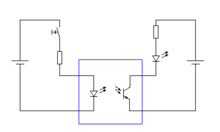
Back عزل كهربائي Arabic Галванично развързване Bulgarian Aïllament galvànic Catalan Galvanické oddělení Czech Galvanisk adskillelse Danish Galvanische Trennung German Aislamiento galvánico Spanish Galvaaniline eraldus Estonian ایزولاسیون الکتریکی Persian Galvaaninen erotus Finnish





Galvanic isolation is a principle of isolating functional sections of electrical systems to prevent current flow; no direct conduction path is permitted.[1][2]
Energy or information can still be exchanged between the sections by other means, such as capacitive, inductive, radiative, optical, acoustic, or mechanical coupling.
Galvanic isolation is used where two or more electric circuits must communicate, but their grounds may be at different potentials. It is an effective method of breaking ground loops by preventing unwanted current from flowing between two units sharing a ground conductor. Galvanic isolation is also used for safety, preventing accidental electric shocks.
- ^ John Huntington Show Networks and Control Systems: Formerly Control Systems for Live Entertainment 2012 ISBN 0615655904, page 98
- ^ Cite error: The named reference
Schneiderwas invoked but never defined (see the help page).
© MMXXIII Rich X Search. We shall prevail. All rights reserved. Rich X Search